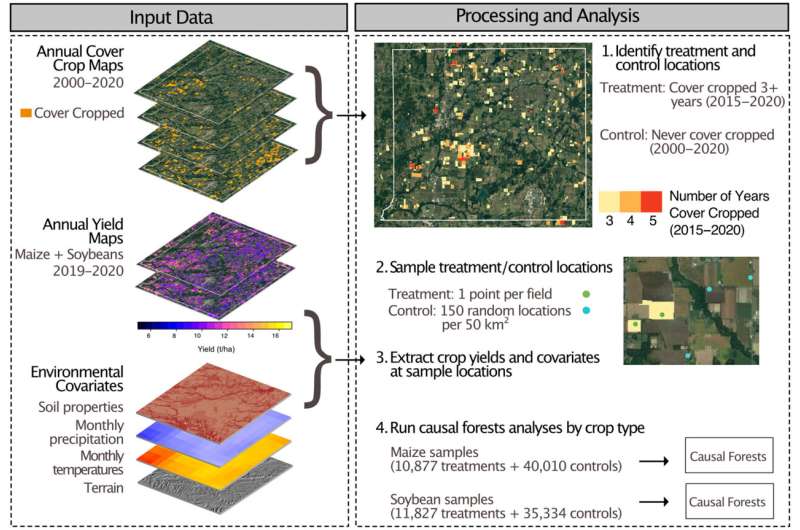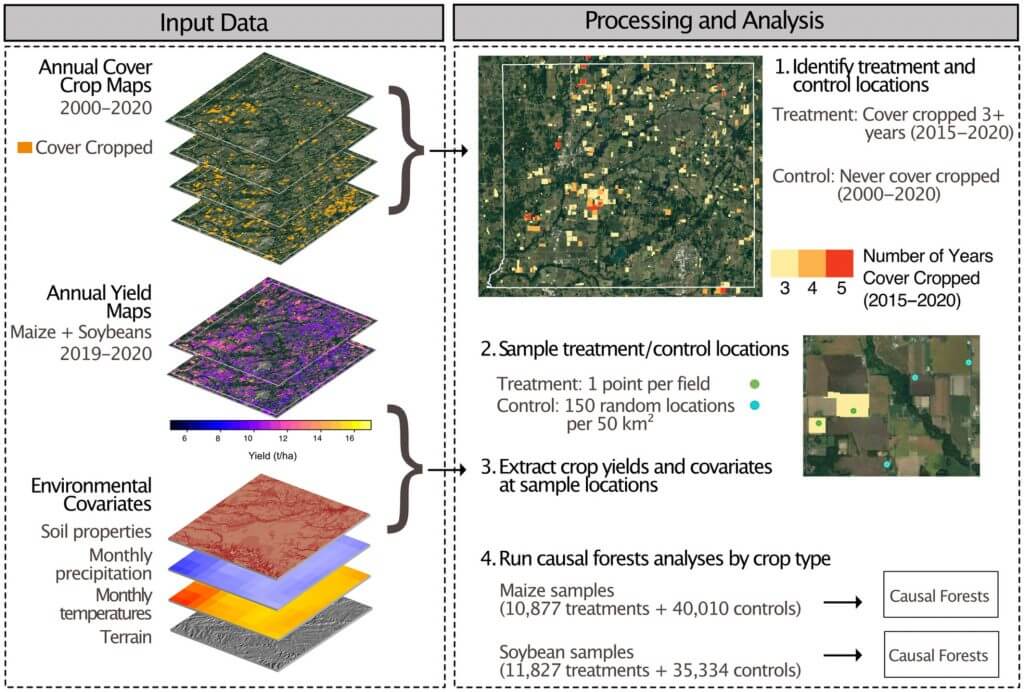
The promise for American agriculture is tantalizing: healthier soil, more carbon kept in the ground, less fertilizer runoff, and less need for chemicals. The reality of planting cover crops during the off-season—a much-touted and subsidized approach to climate change mitigation—is more complicated, according to new Stanford University-led research.
The study, published in Global Change Biology, reveals that cover cropping as currently done in a major U.S. crop-growing region reduces corn and soybean yields, and could lead to indirect environmental impacts from expanded cultivation to make up for the losses.
“Use of cover crops is rapidly spreading. We wanted to see how these new practices affect crop yields in the real world, outside of small-scale research plots,” said Jillian Deines, lead author of the study and a postdoctoral scholar in Stanford’s Center on Food Security and the Environment (FSE) at the time of the research.
“Agriculture is a very tricky business to get right, and things typically don’t work out as planned,” added senior author David Lobell, the Gloria and Richard Kushel Director of FSE and professor in Earth System Science. “Our view is that constant monitoring, evaluation, and learning is a key part of making agriculture truly sustainable.”
Maintaining vegetation cover on agricultural fields in the off-season can lead to large reductions in runoff and leakage of nitrogen into streams and groundwater, reduced soil erosion, and reduced need for weed control chemicals. The practice can also be a cost-competitive strategy for keeping carbon dioxide out of the air.
Because of cover cropping’s potential as a climate change solution and other landscape benefits, the U.S. Department of Agriculture has subsidized the practice with more than $100 million per year since 2016.
The Inflation Reduction Act, passed in August, earmarks $20 billion for practices that “directly improve soil carbon, reduce nitrogen losses, or reduce, capture, avoid, or sequester carbon dioxide, methane, or nitrous oxide emissions, associated with agricultural production.” Without these supports, farmers would likely be slower to take on the cost of sowing and digging up cover crops. As it is, cover crops are used on only about 5% of fields in the primary corn-growing region of the U.S.
Looking at fields from space
In the first large-scale, field-level analysis of yield impacts from cover cropping across the U.S. Corn Belt, the researchers used satellite imagery to look over about 20 million acres of farmland in Iowa, Indiana, Missouri, Ohio, Illinois, and Michigan. They analyzed every field that had grown cover crops for at least three years, comparing them to similar fields that had not been planted with cover crops.
On average, fields with cover crops saw yield declines of 5.5% for corn and 3.5% for soybeans. The greater maize yield losses likely reflect the crop’s greater need for nitrogen fertilizer, a chemical that common cover crops also use, and water, which cover crops can deplete ahead of dry growing seasons.
The yield declines equate with a loss of about $40 per acre for corn and $20 per acre for soybeans. That loss, combined with the cost of implementing cover crops—about $40 per acre—makes long-term adoption of the practice challenging, the researchers write.
Despite the sobering findings, the researchers emphasize that cover crops could still prove beneficial to farmers and the rest of society. It could be that the benefits take a while to kick in, and it’s likely that farmers will become better at implementation. More research can help guide that implementation by showing, among other things, how alternatives to rye—the most commonly used cover crop in the U.S. Corn Belt—might result in higher primary crop yields in some regions.
Ensuring that the cover crop is removed with enough lead time before planting primary crops could reduce the likelihood of significant yield penalties. Policymakers could encourage adoption of cover cropping more strongly in areas that are least likely to experience significant yield penalties, such as those with less susceptibility to water stress.
“Learning by doing is really important, and adjustments are almost always needed both in the sense of farmer practice and government policy,” Lobell said. “The combination of satellite data and powerful machine learning methods can help us be more nimble in making these adjustments.”
More information:
Jillian M. Deines et al, Recent cover crop adoption is associated with small maize and soybean yield losses in the United States, Global Change Biology (2022). DOI: 10.1111/gcb.16489
Journal information:
Global Change Biology
Provided by
Stanford University
Cover crops can lower yields, according to new study (2022, November 8)
retrieved 9 November 2022
from https://phys.org/news/2022-11-crops-yields.html
part may be reproduced without the written permission. The content is provided for information purposes only.

